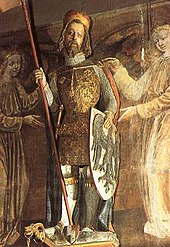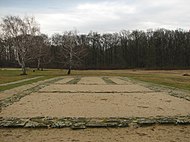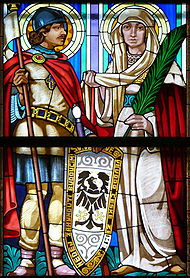History of Christianity in the Czech lands


The history of Christianity in the Czech lands began in the 9th century.
Two
Early Middle Ages (till 976)
Early Slavs (before c. 830)
Archaeological finds with close analogies in
The remains of pagan cult sites, most of which have been excavated in Moravia, are "difficult to interpret."[5] For instance, finds at a cemetery at Mikulčice which was in use from the late 8th century to the middle of the 10th century point at the existence of a rite connected to horse burials.[6] The earliest inhumation graves, dated to the 8th century, were also unearthed in this region.[6] Fortifications at Mikulčice, Staré Město, and nearby settlements proves that important centers of power existed in the valley of the river Morava.[7]
Likewise around 800, strongholds were erected at Kouřim and other places in the Vltava river's valley in Bohemia.[8] Charlemagne's biographer Einhard lists the "Bohemians" among the peoples with whom Charlemagne "had armed conflict."[9][10] The heads or duces[4] of the Bohemian tribes agreed to pay tribute to the emperor in 805 and 806.[11] Bohemian and Moravian emissaries participated at the Diet of Frankfurt in the Carolingian Empire in 822.[12]
Beginnings (c. 830–c. 906)

The earliest
No objects connected to Christianity which can be dated to the period before the mid-9th century have been unearthed in Bohemia.
Mojmir I's nephew and successor,
The Byzantine missionaries' success caused conflicts with the Frankish prelates who accused the two brothers of
[The Moravians] sent to the Apostolic Father, saying. "Since our fathers once received Baptism from Saint Peter, give us Methodius as archbishop and teacher." And the Apostolic Father sent him at once. And Prince Svatopluk and all the Moravians received him. They entrusted to him all the churches and clergy in all the towns. And from that day forth, God's teachings grew greatly and the clergy multiplied in all the towns.
— The Life of Methodius[27]
Moravia underwent a significant territorial expansion in the reign of
Methodius died on April 6, 885.[36] His opponents took advantage of his death and persuaded Pope Stephen V to forbid the use of the vernacular in liturgy.[37] Svatopluk I soon expelled Methodius's disciples from his empire.[38] Svatopuluk I died in 894.[22] The Czechs soon rose up and accepted the suzerainty of King Arnulf of East Francia.[39]
Christianization (c. 906–976)

Wenceslaus I's grandmother Ludmila became the first local saint.[45] She had been murdered in 921 because of her conflicts with her daughter-in-law, Drahomíra (Wenceslaus's mother).[46][34] Her cult began around 925 in the reign of her grandson.[45] Wenceslaus I who was murdered by his own brother's servants[47] also became a subject of veneration.[48] He was regarded as "eternal prince" of Bohemia from the end of the century.[49] The legends of Wenceslaus I and his grandmother are among the first works of local literature.[50] The parallel use of Latin and Old Church Slavonic in a religious context is a remarkable feature of these texts.[51] For instance, the earliest legend of Wenceslaus was written in Latin in the 960s, but its Old Church Slavonic version also appeared in short time.[50]
Wenceslaus's brother Boleslaus I (r. 935–972) defeated a number of Bohemian dukes who opposed his rule, erected new fortresses all over Bohemia, and conquered significant parts of Moravia, Silesia, and other territories.[52] Cosmas of Prague reports that Boleslaus I "built twenty churches for the Christian religion"[53] in his reign.[54] Churches from the second half of the century have been found at Dobřichov, Plzeň, and other settlements.[55] The earliest churches in Bohemia were wooden constructions.[56] The church dedicated to the Virgin at Prague Castle was the first to have been built of stone.[56] Boleslaus I ordered that markets be held on Sundays in his forts in order to persuade his subjects to attend Sunday Mass.[54] Pope John XIII authorized him to establish two bishoprics in his realm in 962, [57] but Michael, Bishop of Regensburg, prevented the division of his diocese.[58] Cosmas of Prague narrates that the Pope forbade Slavic liturgy in his letter to Boleslaus II, but the credibility of this report has been challenged.[51]
Changes in burials reflect the spread of Christianity in Bohemia in the 10th century.
Middle Ages (976–c. 1410)
Development of church structure (976–c. 1200)

A member of the powerful Slavník dynasty, Adalbert, became the bishop of Prague around 983.[58][60] Emperor Henry IV's diploma of 1086 (the text of which has been preserved by Cosmas of Prague) describes the boundaries of Bishop Adalbert's diocese.[58] According to the diploma, Bishop Adalbert's jurisdiction included both Bohemia and Moravia, which suggests that the see of Moravia had meanwhile been dissolved.[61] The diploma states that parts of Silesia, Lesser Poland (including Kraków), and modern Slovakia also belonged to the bishopric in the late 10th century.[59]
Bishop Adalbert attempted to strengthen Christian values in his diocese, for instance by condemning polygamy.[62] However, he failed in his efforts and departed his see for Italy in 988 or 989.[60][63] He only returned to Prague upon the request of Boleslaus II in 992.[60] In next year the duke and the bishop jointly established Břevnov Monastery for Benedictine monks.[62] Bishop Adalbert again left for Rome just before the massacre of his kinsmen by the duke in 995.[64] Adalbert himself suffered martyrdom among the pagan Prussians in 997.[60] His canonization was initiated in 999 by Emperor Otto III.[60]
[Adalbert] planned to set his flock free form the captivity of the

Saint Adalbert's relics were initially buried in the
Bretislaus I's decrees of 1039 make references to archpriests and archdeacons
In the 11th and 12th centuries a number of new monasteries were founded in the Czech lands, most of them by the dukes.
Further history (1410–present)
This section is empty. You can help by adding to it. (August 2013) |
See also
Footnotes
- ^ Barford 2001, p. 64.
- ^ Pánek & Tůma 2009, pp. 58–59.
- ^ Sommer et al. 2007, pp. 215, 217.
- ^ a b Sommer et al. 2007, p. 215.
- ^ Sommer et al. 2007, pp. 216–217.
- ^ a b Sommer et al. 2007, p. 216.
- ^ Barford 2001, p. 109.
- ^ Barford 2001, p. 111.
- ^ Einhard: The Life of Charles the Emperor (ch. 15.), p. 35.
- ^ Vlasto 1970, pp. 86, 345.
- ^ a b c Agnew 2004, p. 10.
- ^ a b Vlasto 1970, p. 24.
- ^ Sommer et al. 2007, pp. 219–220.
- ^ a b c Sommer et al. 2007, p. 221.
- ^ a b c Vlasto 1970, p. 25.
- ^ a b Barford 2001, p. 219.
- ^ a b c Sommer et al. 2007, p. 222.
- ^ Vlasto 1970, p. 86.
- ^ The Annals of Fulda (year 845), p. 24.
- ^ Sommer et al. 2007, pp. 224–225.
- ^ Agnew 2004, pp. 10–11.
- ^ a b c d e f g Agnew 2004, p. 11.
- ^ Pánek & Tůma 2009, p. 66.
- ^ a b c d e f g Pánek & Tůma 2009, p. 67.
- ^ a b Pánek & Tůma 2009, p. 69.
- ^ a b Sommer et al. 2007, p. 228.
- ^ The Life of Methodius (ch. 11.), p. 119.
- ^ Barford 2001, p. 110.
- ^ Barford 2001, p. 112.
- ^ Vlasto 1970, pp. 90–91.
- ^ Sommer et al. 2007, pp. 225–226.
- ^ Sommer et al. 2007, p. 226.
- ^ Sommer et al. 2007, pp. 226–227.
- ^ a b Agnew 2004, p. 12.
- ^ Sommer et al. 2007, p. 227.
- ^ Vlasto 1970, p. 77.
- ^ Vlasto 1970, p. 81.
- ^ Sommer et al. 2007, pp. 223–224.
- ^ Pánek & Tůma 2009, pp. 71, 74.
- ^ a b c d Sommer et al. 2007, p. 224.
- ^ Pánek & Tůma 2009, p. 72.
- ^ Pánek & Tůma 2009, p. 74.
- ^ Vlasto 1970, p. 90.
- ^ a b Sommer et al. 2007, p. 225.
- ^ a b Sommer et al. 2007, p. 234.
- ^ Pánek & Tůma 2009, pp. 74–75.
- ^ Agnew 2004, p. 13.
- ^ Sommer et al. 2007, pp. 234–235.
- ^ Sommer et al. 2007, p. 235.
- ^ a b c Sommer et al. 2007, p. 249.
- ^ a b Vlasto 1970, p. 99.
- ^ Pánek & Tůma 2009, pp. 75–76.
- ^ Cosmas of Prague: The Chronicle of the Czechs (1.22.), p. 71.
- ^ a b Sommer et al. 2007, p. 230.
- ^ a b c Vlasto 1970, p. 97.
- ^ a b c d e f Sommer et al. 2007, p. 247.
- ^ Pánek & Tůma 2009, p. 76.
- ^ a b c d e f Sommer et al. 2007, p. 231.
- ^ a b c d Sommer et al. 2007, p. 232.
- ^ a b c d e Agnew 2004, p. 14.
- ^ Sommer et al. 2007, pp. 231–232.
- ^ a b Pánek & Tůma 2009, p. 77.
- ^ Vlasto 1970, pp. 102–103.
- ^ Vlasto 1970, p. 103.
- ^ The Life of Saint Adalbert Bishop of Prague and Martyr (ch. 12.), pp. 125-127.
- ^ a b Wolverton 2001, p. 115.
- ^ Sommer et al. 2007, p. 233.
- ^ Sommer et al. 2007, p. 244.
- ^ Wolverton 2001, pp. 115–116.
- ^ Wolverton 2001, p. 116.
- ^ Sommer et al. 2007, pp. 247–248.
- ^ a b Sommer et al. 2007, p. 248.
- ^ a b Sommer et al. 2007, p. 245.
- ^ a b Wolverton 2001, p. 126.
- ^ Sommer et al. 2007, pp. 234, 247, 250.
- ^ Wolverton 2001, p. 236.
- ^ Wolverton 2001, pp. 116–117.
- ^ Wolverton 2001, p. 117.
References
Primary sources
- Cosmas of Prague: The Chronicle of the Czechs (Translated with an introduction and notes by Lisa Wolverton) (2009). The Catholic University of America Press. ISBN 978-0-8132-1570-9.
- "Einhard: The Life of Charles the Emperor" (2009). In Charlemagne and Louis the Pious: Lives by Einhard, Notker, Ermoldus, Thegan, and the Astronomer (Translated with Introductions and Annotations by Thomas F. X. Noble). The Pennsylvania State University Press. pp. 21–50. ISBN 978-0-271-03573-4.
- The Annals of Fulda (Ninth-Century Histories, Volume II) (Translated and annotated by Timothy Reuter) (1992). Manchaster University Press. ISBN 0-7190-3458-2.
- "The Life of Methodius" (1983). In Medieval Slavic Lives of Saints and Princes (Marvin Kantor) [Michigan Slavic Translation 5]. University of Michigan. pp. 97–138. ISBN 0-930042-44-1.
- "The Life of Saint Adalbert Bishop of Prague and Martyr (Translated by Cristian Gaşpar)" (2013). In Saints of the Christianization Age of Central Europe (Tenth-Eleventh Centuries) (Edited by Gábor Klaniczay, translated by Cristian Gaşpar and Marina Miladinov, with an introductory essay by Ian Wood) [Central European Medieval Texts, Volume 6.]. CEU Press. pp. 77–182. ISBN 978-615-5225-20-8.
Secondary sources
- Agnew, Hugh (2004). The Czechs and the Lands of the Bohemian Crown. Hoover Institution Press, Stanford University. ISBN 978-0-8179-4492-6.
- Barford, P. M. (2001). The Early Slavs: Culture and Society in Early Medieval Eastern Europe. Cornell University Press. ISBN 0-8014-3977-9.
- Pánek, Jaroslav; Tůma, Oldřich, eds. (2009). A History of the Czech Lands. ISBN 978-80-246-1645-2.
- Sommer, Petr; Třeštík, Dušan; Žemlička, Josef; Opačić, Zoë (2007). "Bohemia and Moravia". In Berend, Nora (ed.). Christianization and the Rise of Christian Monarchy: Scandinavia, Central Europe and Rus', c.900-1200. Cambridge University Press. pp. 214–262. ISBN 978-0-521-87616-2.
- Vlasto, A. P. (1970). The Entry of the Slavs into Christendom: An Introduction to the Medieval History of the Slavs. Cambridge University Press. ISBN 978-0-521-10758-7.
- Wolverton, Lisa (2001). Hastening Toward Prague: Power and Society in the Medieval Czech Lands. University of Pennsylvania Press. ISBN 0-8122-3613-0.
